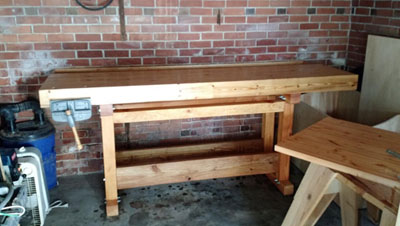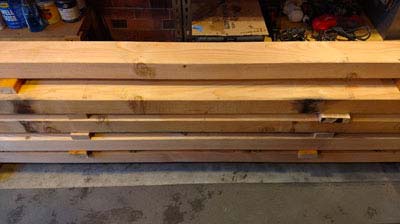|
Bench Build With A Twist - Part One
Click on any picture to see a larger version.
Ever since Woodworker, Author, Editor, Publishing magnate, and all around great guy, Chris Schwarz, literally re-wrote the
book(s) on workbench building
, the woodworking community has been smitten with the 18th century
Andre Roubo workbench design
.
This has translated into everything from a small cottage industry making products specific to Roubo bench building, (
Benchcrafted
,
Lake Erie Tool Works
) to an endless parade of "bench building" blog series and forum posts.
Add this to the list.
I am a hopeless addict when it comes to vintage woodworking equipment,
hand tools
, and building workbenches. I just can't resist.
I had always worked on, and have built several "Continental," or European style workbenches. One Tage Frid inspired, and the most recent, a European inspired bench without the shoulder vise. There were times previously that I thought I was going to have to have my hip replaced from bouncing off that damned shoulder vise, as useful as it may have been.

|
When I began the process of restarting/rebuilding my woodworking shop, I knew I wanted a European bench, as this design is well known to, and comfortable for me.
Around this time, I discovered Saint Schwarz, and was liberated by a number of points he makes regarding, most pointedly, the use of cheap, available lumber for bench building. What a game changer.
Having someone come out and say that the use of timber like Southern Yellow Pine or Douglas Fir was more than acceptable for building a bench, made for something of a mixed blessing.
On the one hand, it opened Pandora's box for me as it made the construction of exactly the kind of bench I wanted, with a thick top, and WAY over built base, far more attainable financially.
On the other hand, it opened Pandora's box for me because, discovering the viability of such relatively cheap lumber makes it all too easy to spend an inordinate amount of time building workbenches rather than furniture.
A delightful paradox despite being confusing to loved ones who can not wrap their heads around the need for making more than one workbench. Ah, how innocent they all are.
After building the Continental bench, my craving seemed satisfied. But the more I worked with it, and the more I found myself longing to get back to a more hand tool (or Neanderthal) focused method of working wood, the more I had to confess that the Roubo or Holtzapffel design made sense.
"
The Tiny Shop
", my "intimate" one car garage sized workshop is the home and world headquarters of The Madcap Woodwright.
It is also very, very, small.
Despite its size, I did have enough space in front of my table saw for another bench, if that bench were to, say, double as an outfeed table. I could modify the dimensions of the existing outfeed table to make a little more breathing room both at its end and also on either side if I were to build another bench. (Rationalization is a wonderful thing for a workbench addict.)
The thing that finally greenlighted a second bench build was that the ideal height of a proposed Neanderthal focused workbench just happened to be exactly the height required for an outfeed table for my tablesaw. BINGO!
That was all I needed.
That was all it took to send me skipping gleefully to the local BORG (Big Orange Retail Giant) home center to start the wood selection process. More on this later.
In this series, it is true that I will be documenting the building of my second workbench, like so, so, many more before me.
It is my hope however, that the writing of this series and the views and philosophical approach I take, will separate this series from those that have come before.
A Little About The Design
I won't go too deep into the historical and scholastic importance of the Roubo bench. It has been beaten to death, and frankly, Chris Schwarz has the corner on this particular market. I would be embarrassing myself were I to attempt it.
I will say though, that the legs being flush with the very thick top, the traditional leg vise, and the dog holes intended for use with
hold fasts
, are exactly the combination of things that made this build something of a "Must do" for me. It ticks all sorts of boxes for both my hand tool working needs, as well as...well...let's face it, I just wanted to build another bench. If I had more space in my shop, I would be digging through the local big box lumber racks for timbers for the Nicholson bench I would be building to complete the set after this Roubo is done.
Speaking of lumber, this is a good place to say, I am building this bench with very little in the way of regard to how many, many others have built theirs. It is somewhat of a departure in that, I am really going to be beating the hell out of this bench after it is done. Therefore, while I am going to be applying traditional joinery, and also applying the sort of attention to detail that timber deserves, I will NOT be building a "shop queen" "show piece" workbench. I did that once, and was on pins and needles the whole time I had it in my shop. No, I will be using this like it should be used.
I am also taking the risk and laminating large 4"x6" dimensional timbers rather than milling 2"x10" or 2"x12" boards down into smaller laminations as is traditionally done for these builds. Been there, done that, and just WANT to do it this way. The argument that the thing won't stay flat or will try to tear itself apart is well known to me, and honestly, I am fine with flattening this aircraft carrier a few more times before it finally settles down. Besides that, through some sort of freak alignment of the stars, virtually all the timbers I selected were very close to quarter sawn, and therefore, better than what I had to choose from otherwise...so there.
Once the timbers were procured, I stickered and stacked them in The Tiny Shop for a little over two months.

|
Now, with timbers drying and settling into something that resembles a state of equilibrium, I set about firming up dimensions and a plan of procedure for its construction. (Thank you Don Rauh for pounding "PLAN OF PROCEDURE" into my head.)
Looking forward to episode two of this rebellious bench build, I will go over the steps I chose to begin the epic build of "The Madcap Roubo."
Until then, stay joyous and remember that life is just too short.
To continue to Part 2 of this series, Click Here
John McBride is a professional woodwright, blogger, and writer, living and working joyfully and with abandon in Denver, Colorado.
|